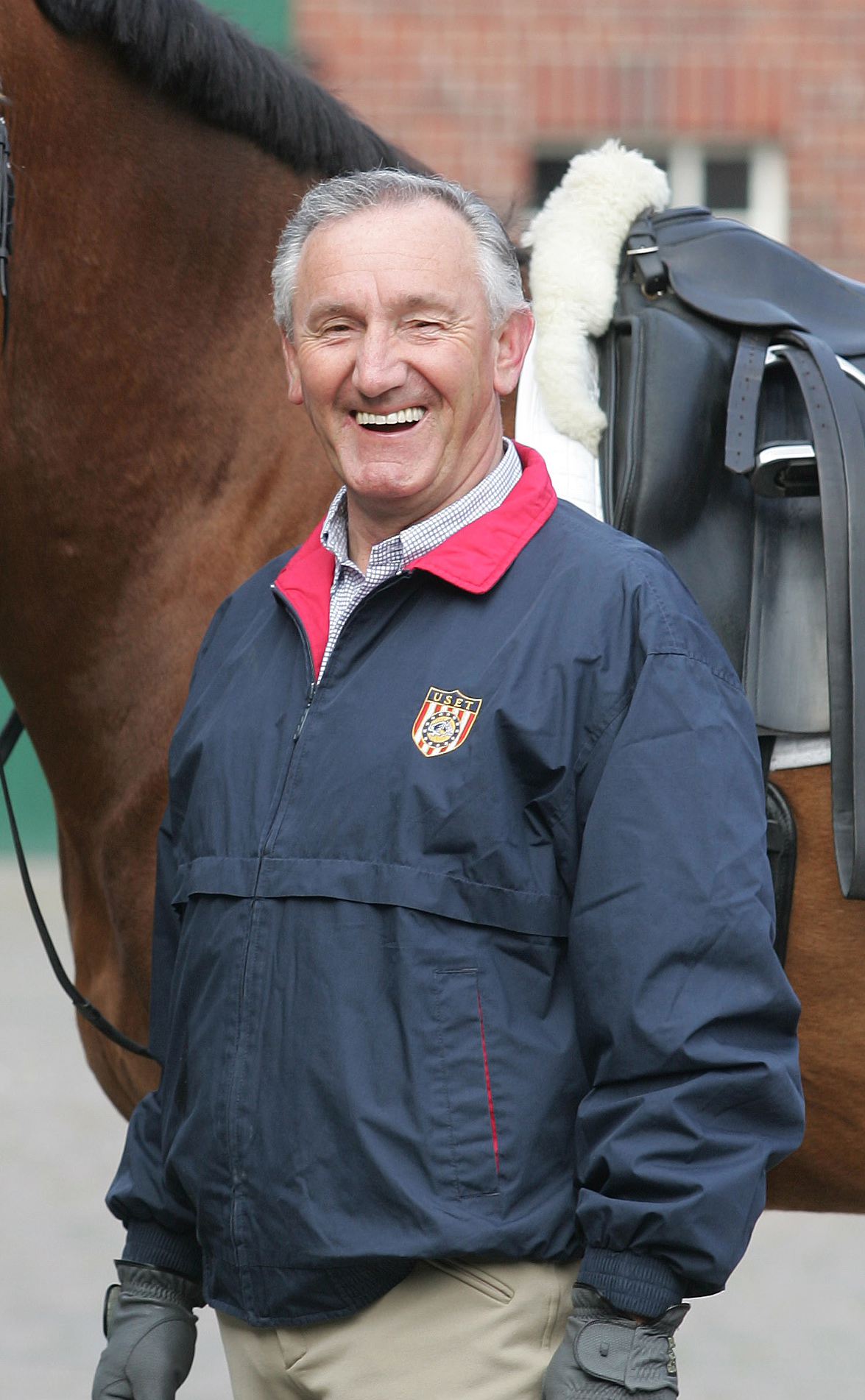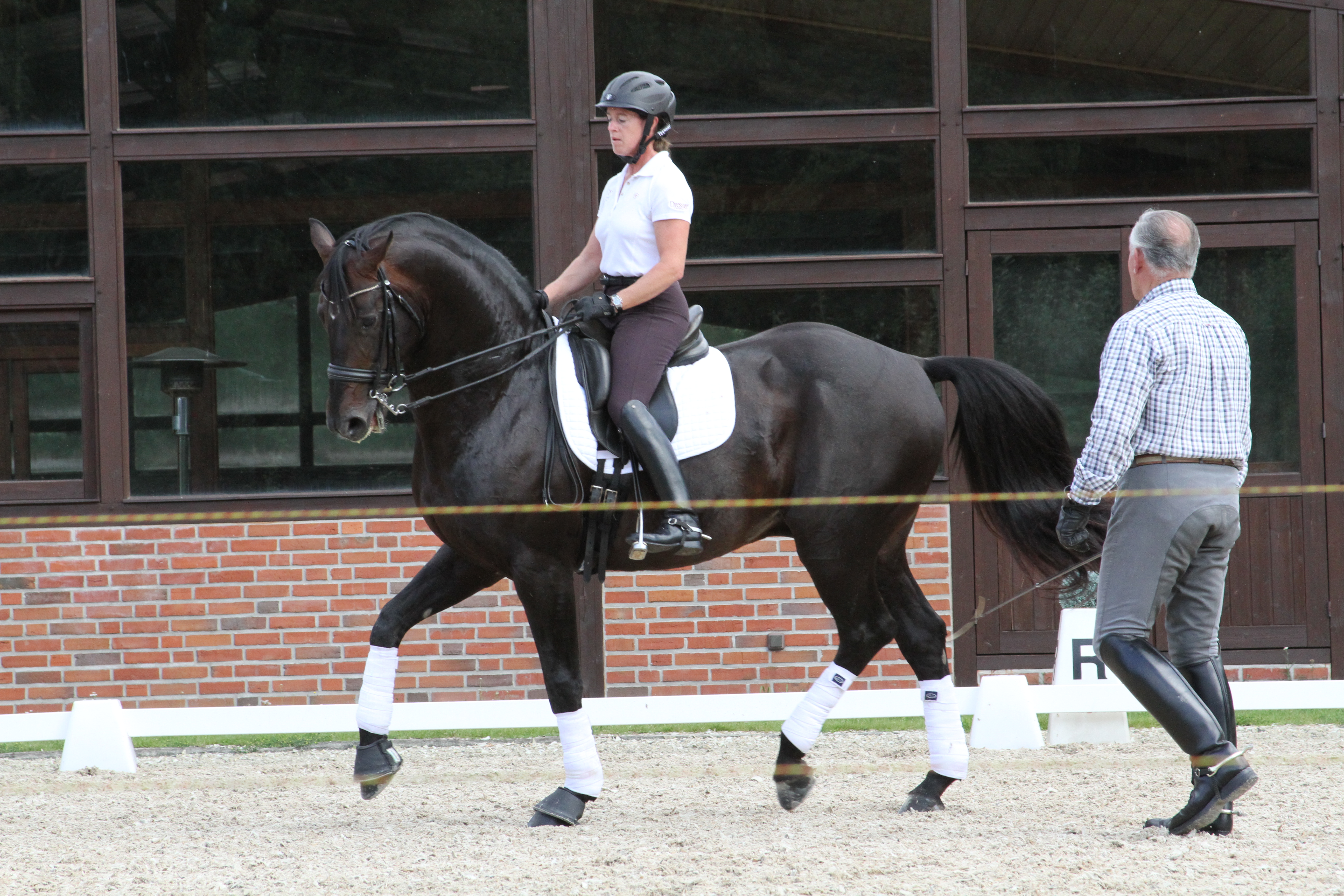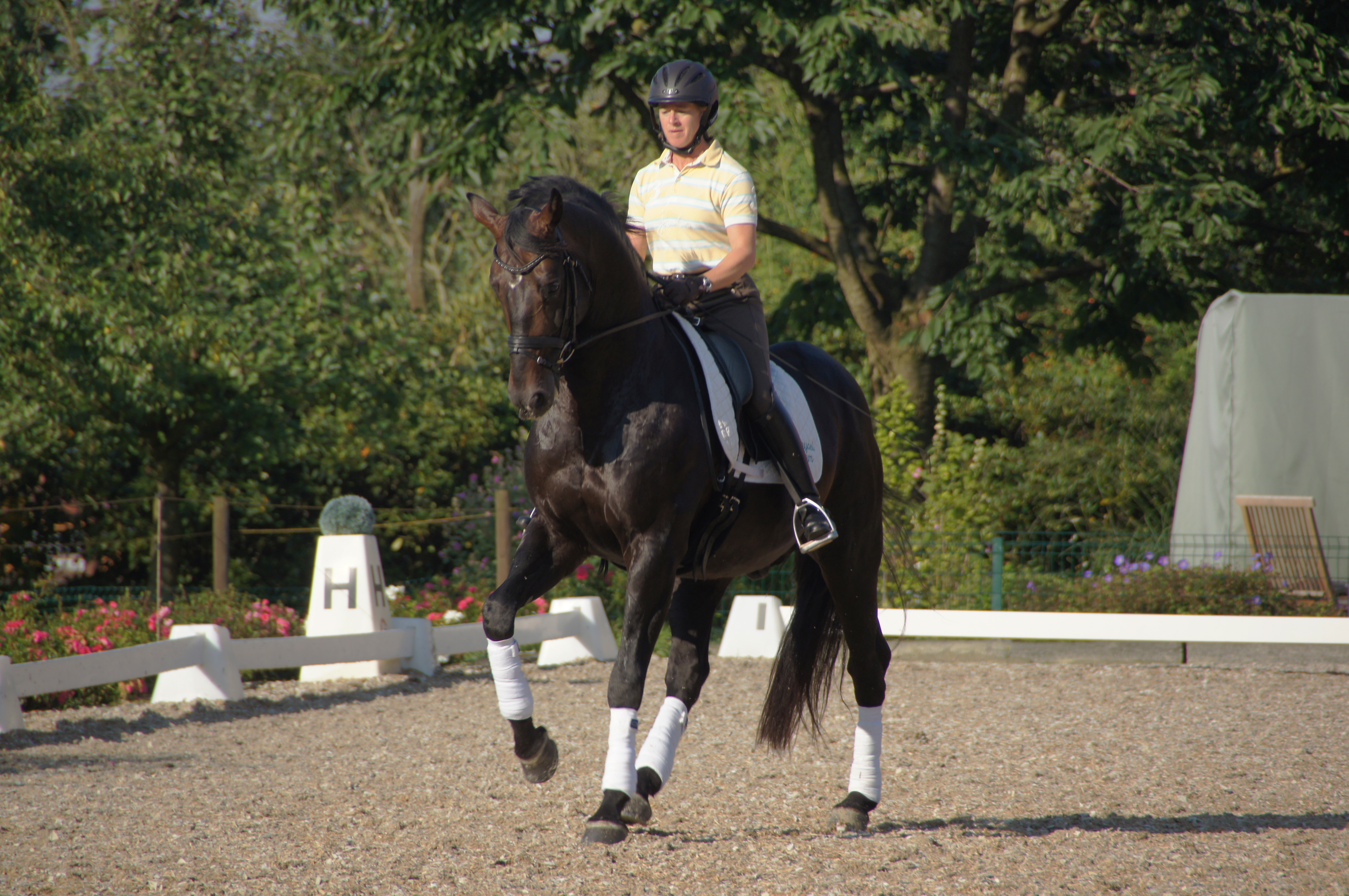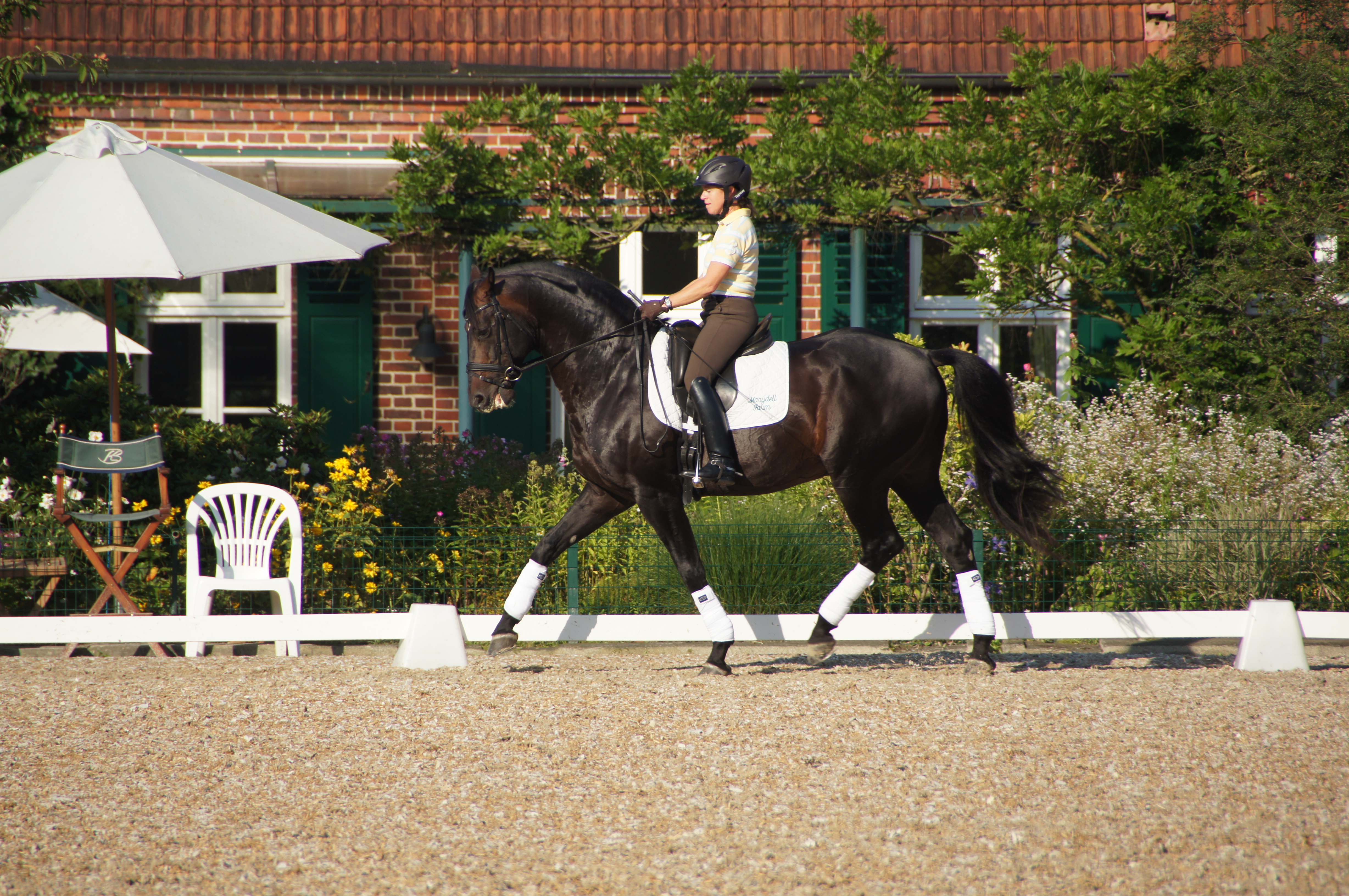This story is from the Dressage Today archives and first appeared in the June 2012 issue of Dressage Today.
I needed to give myself a good pinch just to make sure I wasn’t dreaming. Training with Klaus Balkenhol is every dressage rider’s dream, and in 2011 I spent eight weeks there with two horses: Don Principe, a 12-year-old Hanoverian stallion owned by Maryanna Haymon, and my own 9-year-old Hanoverian gelding, DeWert. On arriving in Rosendahl, Germany, I was immediately aware that every horse in Klaus’ barn moved with an extra degree of expression and cadence. I was inspired before I even got on a horse. “Eindruck” was a word I heard Klaus use often. Literally, the word means “impression,” but he used it to encompass the notion of presence, expression and cadence. That extra expression required a higher degree of self-carriage from the horse, which in turn, required more fitness.

As an Amazon Associate, Dressage Today may earn an affiliate commission when you buy through links on our site. Product links are selected by Dressage Today editors.
My main goal was to create the quality I witnessed from my first moments at this stable and make that habitual. With regular help from Klaus, as well as extra time to figure things out on my own and devote to Prince’s fitness plan, I was on a great path. With time, I was able to increase the strength and suppleness of my horses and develop the level of collection, expression and cadence that was expected there. I found the key to this new degree of expression through achieving three goals: the swinging back in the warm-up, the collection and cadence in the work session and the riding of exercises such as transitions on a circle.

Klaus Balkenhol: The Real Deal
Klaus Balkenhol is a two-time Olympic team gold medalist and an individual bronze medalist. The former U.S. team dressage coach has a great depth of experience training students like his daughter, Anabel, and Britain’s Laura Bechtolsheimer.
Klaus has a quiet, calming influence on horses and his horses engage and balance from his invisible aids. That’s just what’s supposed to happen, and when I got back on my horses after he rode them, I felt a huge difference. While I was riding, he often helped my horses achieve the right kind of activity from the ground, giving me the correct feeling in the saddle. I got a lot out of watching both Klaus and Anabel. Watching good riding is invaluable. You memorize what you want, and it inspires you to achieve more. The best thing about watching Klaus is seeing his obvious love for the sport and for horses. He is demanding, but he always knows when to reward the horse, move onto something else or finish. I think it says a lot that he often smiles when riding and especially when talking about horses.—Jennifer Baumert
Warm-Up Goals: Activity, Relaxation and a Swinging Back
From the moment you start the warm-up, Klaus expects horses to move with an active hind leg, swinging back and a stretch that’s appropriate to their level of balance. When I arrived, I had activity in my warm-up, but Klaus encouraged me to slow the tempo to preserve the relaxation in my horses. Over time, however, slowing the tempo led to loss of activity—the key ingredient to making the back swing and the half halts go through. I needed to get the right balance between activity and supple relaxation. Klaus’ warm-up program helped achieve a truly back-to-front connection with activity, suppleness, throughness and swing in the back.
That swing in the back was the channeling of activity from the hind leg through the back to the bit and back to the hind leg in half halts. That connection works both forward and back and is what makes the back swing. It feels like you’re being lifted in a swinging gait.
Some horses naturally swing more than others, but no horse swings through the back without a certain kind of activity. That activity must be offered by the horse, and it makes a relaxed, supple connection. Pushing or driving for activity doesn’t create a relaxed connection. For Prince and for many horses, improving reactivity or promptness to the aids is what creates the relaxed energy and connection that give you swing in the back. When you have it, you feel like you’re being lifted in a swinging, somewhat self-perpetuating (in front of the leg) motion. I say “somewhat self-perpetuating” because even after the horse is in front of the leg, he will need reminders. You want the feeling that a forward, downward or sideways response is always available.
In upward transitions, Prince was quite eager to go forward, but like many horses, he was inclined to offer quantity instead of quality. I wanted to improve the quality of the activity. The word most often used in Germany was fleissig. It means “industrious.” In the U.S., we say “active” or “working,” but the German word is better. We want the horse’s movement to be industrious and in front of the leg. I needed activity in the hind legs without running. One way to achieve activity without running is to insist on transitions that are initiated from the hind leg. When the first step is with the hind leg, you feel your horse lift his back and round his topline in self-carriage. When the horse makes the first step with the front leg, you feel him flatten or hollow. His gait will then be as fast or as slow as he wants.
In the downward transitions and half halts, Prince needed to be forward-thinking so he didn’t lose the activity in the lower gait. One way to ensure your horse does not just slow down or quit in downward transitions is to make many preparations for downward transitions or “almost” downward transitions. When you feel your horse begin to lose activity in the downward, remind him that his hind legs must not lose activity and then either proceed with the downward or surprise him by continuing forward in the same gait.
In the sideways aids, Prince needed to learn to be prompt to the aids and then maintain the cadence instead of speeding up his tempo. For example, it took time to develop cadence, that dance-like quality, in Prince’s half pass. To the left, he would dance, flatten, then dance again, but I could feel that it would come.
The swinging back in the warm-up provides the positive tension and the suppleness required for the collection we would focus on in the work session.

DT Editor’s Note: Want to learn more from Klaus Balkenhol? Check out the book “Klaus Balkenhol: The Man and His Training Methods” by Britta Schoffmann.
Work-Session Goals: Collection, Cadence and Expression
After taking a walk break, Klaus insisted on instantaneous collection with expression as soon as the work session began. If you successfully achieve that self-perpetuating, swinging activity in the warm-up, collection just happens. It’s easy to enhance movement when the back already swings.
Collection & Cadence.
Collection: An improvement in the horse’s balance in which he carries more weight on his hindquarters. He takes shorter steps without losing impulsion, causing the hind legs to bend more and the hindquarters to lower, giving the horse a shorter, uphill frame. The neck arches and stretches upward.
Cadence: Enhanced rhythm due to the activity. Cadence is a byproduct of activity, rhythm and self-carriage.
The goals of the work session are an extension of the warm-up. Klaus added more difficult transitions, figures and movements, but the goal was always to increase suppleness, activity and cadence while minimizing tension.
In response to the forward aids, Prince needed to round, lift and carry himself forward. Half halts were important for organizing the forward energy.
You can expect the same qualities in a half halt that you expect in a downward transition. They must go through to the hind leg but also maintain activity and forward-thinking. Those transitions and half halts that go through help you gain and retain access to the hind leg—that is, you can feel the horse’s hind legs and influence them. The horse lets you “into” his body. When you go forward, you do it in self-carriage rather than getting flat or fast. When you come back, you can add weight to the hind legs. You have to remember to give with your hands often, which gives your horse lots of opportunities to carry himself.
Once the half halts were going through and Prince was in active self-carriage, the driving aids didn’t make him fast or flat and it was easy to give.
From this situation, you can find whatever trot or canter expression you want within the ability of your horse. You can ride him bigger or smaller with the same amount of energy. Exploring these different trots can help you to increase your horse’s collection, cadence and expression.
Trot transitions on a circle: Do transitions between collected and medium trot on a circle, being careful not to let the tempo change. The collection has to have the same degree of energy as the medium paces. The bend of the circle helps you keep your horse supple and gives you a bit of leverage. You want to feel that your horse stays with you and in self-carriage when you drive. He lifts you instead of running. If you have a horse that does piaffe and passage, you can make the passage less ground-covering than you ultimately want in order to close his frame. Then you can easily make it more ground-covering. This will also help with transitions in and out of piaffe.


DT Editor’s Note: Check out the book “Klaus Balkenhol: Success with Sympathetic Hands” by Roland Blum.
My Personal Challenge
Throughout this work, my personal challenge was to stop being a student. In the beginning, I was trying so hard to do exactly what Klaus said that I was always a little behind the eight ball. I was making aids when I was told to instead of from feel. As a result, my timing was off and the aids often had the wrong effect. I pride myself in being a good student and giving myself completely to my trainer, but I realized I needed to use my toolbox of transitions and movements as I did at home to improve Prince’s balance by feel.
For example, Klaus would remind me to half halt before my corners, but when the half halts didn’t go through, it was up to me to repeat the corner or to do a downward transition. Klaus expected me to come to the arena each day with my toolbox and use it. I felt like I had left it in the United States and needed to reclaim it. I was trying so hard to do exactly what he wanted that I was paralyzed, and I felt my confidence level plummet. Finally, I came to a turning point when I just decided to do my own thing at times.
My confidence and progress picked up tenfold once I reclaimed my toolbox. That meant making transitions when my half halts did not go through and using them to gain access to my horses’ hind legs. Using shoulder-in, half pass and other movements I chose, developed the collection, and I repeated corners when they did not set me up for success in a movement. As soon as I took Klaus’ lessons and learned to process them as an independent rider, I got much more out of my time in Germany and was able to develop the expression I had seen when I first arrived.
I absolutely loved riding Prince. He is talented, honest and nicely sensitive. There were times when he was begging to do more and seemed disappointed to cut the work short and go on a hack. That was a sure sign that the work was on the right track, and he was enjoying it.
DT Editor’s Note: If you love learning from Jennifer and Beth Baumert, check out Beth’s book “When Two Spines Align.”
An Owner’s Story by Maryanna Haymon
In 2003, my husband, Wendell, and I came to a point in our breeding program where we decided it was financially in our best interests to acquire a breeding stallion. The goal for our Marydell Farm is to produce amateur-friendly horses with three correct gaits, a good work ethic, the athleticism to compete at the top of sport and the conformation to stand up to the job.

Our broodmares consisted of the Hanoverian “R” line founded by Rubinstein and known for rideability. We wanted to cross them with a “D” line (Donnerhall) son. We needed a super temperament and a horse that could compete up to the Prix St. Georges level because American breeders like a stallion with a performance record. With all this in mind, we looked at 13 stallions that June in Germany and came to the conclusion that Don Principe (aka Prince) was a perfect fit. He epitomizes the term “gentleman” and has taken four different riders to success at the FEI levels. He was the U.S. Equestrian Federation Reserve Champion Dressage Breeding Sire for 2010 and 2011. In 2012, he will stand at Hilltop Farm in Colora, Maryland.
This article first appeared in the June 2012 issue of Dressage Today magazine.
Click here to read more articles with Jennifer Baumert.
Jennifer Baumert is a U.S. Dressage Federation (USDF) bronze, silver and gold medalist and a Certified Instructor through Fourth Level. She has won numerous top-10 USDF Horse of the Year awards. Her Hanoverian gelding, DeWert, was eighth in the nation at Fourth Level.











